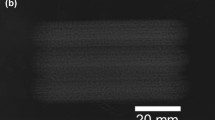Abstract
The morphology of hybrid coatings based on polyester, melamine resin, and various amounts of silica has been investigated, and the hardness and scratch resistance were determined. By increasing silica content, an increase of silica particles in size and number was observed. Small silica particles were preferentially present at the surface. The influence of the silica content on the König hardness, indentation hardness, and elastic modulus was minor. The improved scratch resistance determined for a hybrid coating with 11.4 wt% silica, compared to a similar organic coating without silica, was attributed to small silica particles preferentially present at the surface.
Similar content being viewed by others
References
Mascia, L., “Developments in Organic-Inorganic Polymeric Hybrids: Ceramers,”Trends Polym. Sci., 3, No. 2, 61 (1995).
Brinker, C.J. and Scherer, G.W.,Sol-Gel Science: The Physics and Chemistry of Sol-Gel Processing, Academic Press, Inc., San Diego, 1990.
Sanchez, C. and Livage, J., “Sol-Gel Chemistry from Metal Alkoxide Precusors,”New J. Chem., 14, 513 (1990).
Schmidt, H., “Organic Modification of Glass Structure,”J. Non-Cryst. Solids, 112, 419 (1989).
Maï, C., Cornu, J.F., Bouras, S., Vassoille, R., and Perez, J., “Mechanical Properties of a Hybrid-Oxide Glass,”Eurogel ’91: Proc. Eur. Conf. Sol-Gel Technol. 2nd, 399 (1991).
Mark, J.E. and Pan, S.-J., “Reinforcement of Polydimethylsiloxane Networks by In-situ Precipitation of Silica: A New Method for Preparation of Filled Elastomers,”Makromol. Chem. Rapid Commun., 3, 681 (1982).
Huang, H.-H., Wilkes, G.L. and Carlson, J.G., “Structure-Property Behaviour of Hybrid Materials Incorporating Tetraethoxysilane with Multifunctional Poly(tetramethylene oxide),”Polymer, 30, 2001 (1989).
Wen, J. and Wilkes, G.L., “Organic/Inorganic Hybrid Network Materials by the Sol-Gel Approach,”Chem. Mater., 8, 1667 (1996).
Kioul, A. and Mascia, L., “Compatibility of Polyimide-Silicate Ceramers Induced by Alkoxy Silane Coupling Agents,”J. Non-Cryst. Solids, 175, 169 (1994).
Schrotter, J.C., Smaïhi, M., and Guizard, C., “Polyimide-Siloxane Hybrid Materials: Influence of Coupling Agents Addition on Microstructure and Properties,”J. Appl. Polym. Sci., 61, 2137 (1996).
Landry, C.J.T., Coltrain, B.K. and Brady, B.K., “In-situ Polymerization of Tetraethoxysilane in Poly(methyl methacrylate): Morphology and Dynamic Mechanical Properties,”Polymer, 33, 1486 (1992).
Cuney, S., Gérard, J.F., Dumon, M., Pascault, J.P., Vigier, G., and Dusek, K., “Hydroxyl-Terminated Oligomers Crosslinked by Alkoxysilane Sol-Gel or Polyurethane Chemistries: A Comparison,”J. Appl. Polym. Sci., 65, No. 12, 2373 (1997).
Schmidt, H., Seiferling, B., Philipp, G. and Deichmann, K.,Ultrastructure Processing of Advanced Ceramics, Mackenzie, J.D., and Ulrich, D.R. (Eds.), John Wiley & Sons Inc., New York, 651, 1988.
Kasemann, R. and Schmidt, H., “Coatings for Mechanical and Chemical Protection Based on Organic-Inorganic Sol-Gel Nanocomposites,”New J. Chem., 18, 1117 (1994).
Iwamoto, T. and Mackenzie, J.D., “Ormosil Coatings of High Hardness,”J. Mater. Sci., 30, 2566 (1995).
Wen, J. and Wilkes, G.L., “Synthesis and Characterization of Abrasion Resistant Coating Materials Prepared by the Sol-Gel Approach: I. Coatings Based on Functionalized Aliphatic Diols and Diethylene Triamine,”J. Inorg. Organomet. Polym., 5, 343 (1995).
Gupta, N., Sinha, T.J.M., and Varma, I.K., “Development of an Abrasion Resistant Coating from Organic-Inorganic Polymeric Network by Sol-Gel Process,”Indian J. Chem. Technol., 4, 130 (1997).
Wang, B. and Wilkes, G.L., “Novel Hybrid Inorganic-Organic Abrasion-Resistant Coatings Prepared by a Sol-Gel Process,”J. Macromol. Sci. Pure Appl. Chem., A31, No. 2, 249 (1994).
Frings, S., Meinema, H.A., Van Nostrum, C.F., and Van der Linde, R., “Organic-Inorganic Hybrid Coatings for Coil Coating Applications Based on Polyesters and Tetraethoxysilane,”Prog. Org. Coat., 33, 126 (1998).
Frings, S., Van Nostrum, C.F., Lutke-Schipholt,N., Van der Linde, R., Meinema, H.A., and Rentrop, C.H.A.,Proc. 26th Waterborne High-Solids, & Powder Coating Symp., 35, New Orleans, 1999.
Jones, F.N. and Subrayan, R.P., “Evolution of Melamine-Formaldehyde Resin Science and Technology,”Polym. Mater. Sci. Eng., 77, 389 (1997).
Subrayan, R.P. and Jones, F.N., “13C-NMR Studies of Commercial and Partially Self-Condensed Hexakis(methoxymethyl)melamine (HMMM) Resins,”J. Appl. Polym. Sci., 62, 1237 (1996).
Iler, R.K.,The Chemistry of Silica, John Wiley & Sons Inc., New York, 1979.
Wicks, Z.W., Jones, F.N., and Pappas, S.P.,Organic Coatings: Science and Technology, Vol. 1, Chap. 8, John Wiley & Sons Inc., New York, 1992.
Oliver, W.C. and Pharr, G.M., “An Improved Technique for Determining Hardness and Elastic Modulus Using Load and Displacement Sensing Indentation Experiments,”J. Mater. Res., 7, No. 6, 1564 (1992).
Li, K., Wu, T.W., and Li, J.C.M., “Contact Area Evolution During an Indentation Process,”J. Mater. Res., 12, No. 8, 2064 (1997).
Fink-Jensen, P., “Hardness Testing of Organic Coatings,”Pure Appl. Chem., 10, No. 3, 247 (1965).
Berlin, H. and Hartmann, K., “Mikroeindringhärte-Pendeldämfung Wichtige Meßmethoden zur Beurteilung der Schutzfunktion von Lackfilmen,”FATIPE Q-Kongr, 21th, 271 (1992).
Wicks, Z.W., Jones, F.N., and Pappas, S.P.,Organic Coatings: Science and Technology, Vol. 2, Chap. 23, John Wiley & Sons Inc., New York, 1992.
Wu, S. and Soucek, M.D., “Effect of Siloxane Functionalized Caprolactone Polyols on Photocurable Epoxy Coatings,”Journal of Coatings Technology,70, No. 887, 53 (1998).
Author information
Authors and Affiliations
Corresponding author
Additional information
Dept. of Polymer Chemistry and Coatings Technology, P.O. Box 513, 5600 MB Eindhoven, The Netherlands.
Materials Division, Dept. of Materials Chemistry and Coatings, P.O. Box 595, 5600 AN Eindhoven, The Netherlands.
Rights and permissions
About this article
Cite this article
Frings, S., van Nostrum, C.F., van der Linde, R. et al. Morphology of hybrid coatings based on polyester, melamine resin, and silica and the relation with hardness and scratch resistance. Journal of Coatings Technology 72, 83–89 (2000). https://doi.org/10.1007/BF02697993
Issue Date:
DOI: https://doi.org/10.1007/BF02697993




